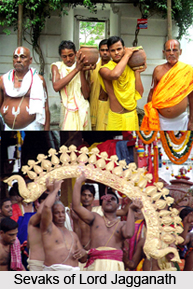 The sebakas who serve the Jagannath Temple of Puri have been categorized based on their nature of appointment and importance of their services. Different sebakas have assumed different status in the constellation of ritual services. The various categories of sebakas are Swata Sebayat, Mahashrama Nijoga, Kotta Sebayat, Khatani Sebayat, Parajatra Sebayat and the Khatanihara Sebayats.
The sebakas who serve the Jagannath Temple of Puri have been categorized based on their nature of appointment and importance of their services. Different sebakas have assumed different status in the constellation of ritual services. The various categories of sebakas are Swata Sebayat, Mahashrama Nijoga, Kotta Sebayat, Khatani Sebayat, Parajatra Sebayat and the Khatanihara Sebayats.
Swata SebayatorAngilaSebayat
The Suaras and the Chaitas belong to this category. Cooking foods and making sweets which are offered to the deities are the birthright of the Suaras and safeguarding the deities is the hereditary duty of the Chaitas. There is no need on the part of these sebakas for obtaining permission from the authorities to perform such services. They do not adopt children from other sebaka communities and keep the homogeneity in their castes and ritual services intact.
Mahashram Nijoga
The sebakas belonging to this category are temple authorities who supervise the temple affairs. The Parichhas fall into this group. Though they perform services in the temple on a hereditary basis they are required to obtain special permission from the king. They keep accounts and supervise various works specially meant for maintaining liaison between the temple and the king.
Kotta Sebayat or Raj Angila
The sebakas who belong to this class are Pratihari (Gochikar.Bada-duara, Dhokadi, Bhogamandapa, Duaraghar and others), Supakar (Suara, Badusuara, Panti badu and others) and Bhitar Sebayat (Khuntia, Garabadu and others). The Bhitara Sebayat is a big group which consists of 34 Nijogas of sebakas. Though the sebakas of this group have birthright to serve the temple in their respective ritual duties it is necessary for them to obtain permission from the king for performing ritual services in the temple.
Khatani Sebayat
The sebakas of this category may be doing certain services on a hereditary basis or they may be of any additional group or caste. Considering the necessity of some services the king permits certain persons to do some specific jobs in the temple for a specified period of time. The sebakas included in this category are Daraji (tailor) Page patuka, Mandali and Kottasuansia.
Parajatra Sebayat
The sebakas included in this category have right to work in the temple on a hereditary basis; but their services are confined to festive occasions, and they are qualified to perform their duties only after they undergo the ceremony of Saddi bandha, a ceremony of investiture performed when a sebaka is granted to do a seba in the temple.
Khataniham Sebayat or Sahayakari Sebayat
When the inflow of tourists increased in Puri due to better facilities the sebakas of the temples realised that the business of looking after the pilgrims were more remunerative than their hereditary ritual services in the temple. As a result they devoted more time to the pilgrims and looked after their comforts during their stay at Puri and earned substantially from this source. Finding little time to perform ritual services by themselves the sebakas appointed their deputies to perform services on their behalf. These deputies are called Khatanihara sebakas whose number has increased in the present age with the increase in flow of pilgrims in Puri.





















